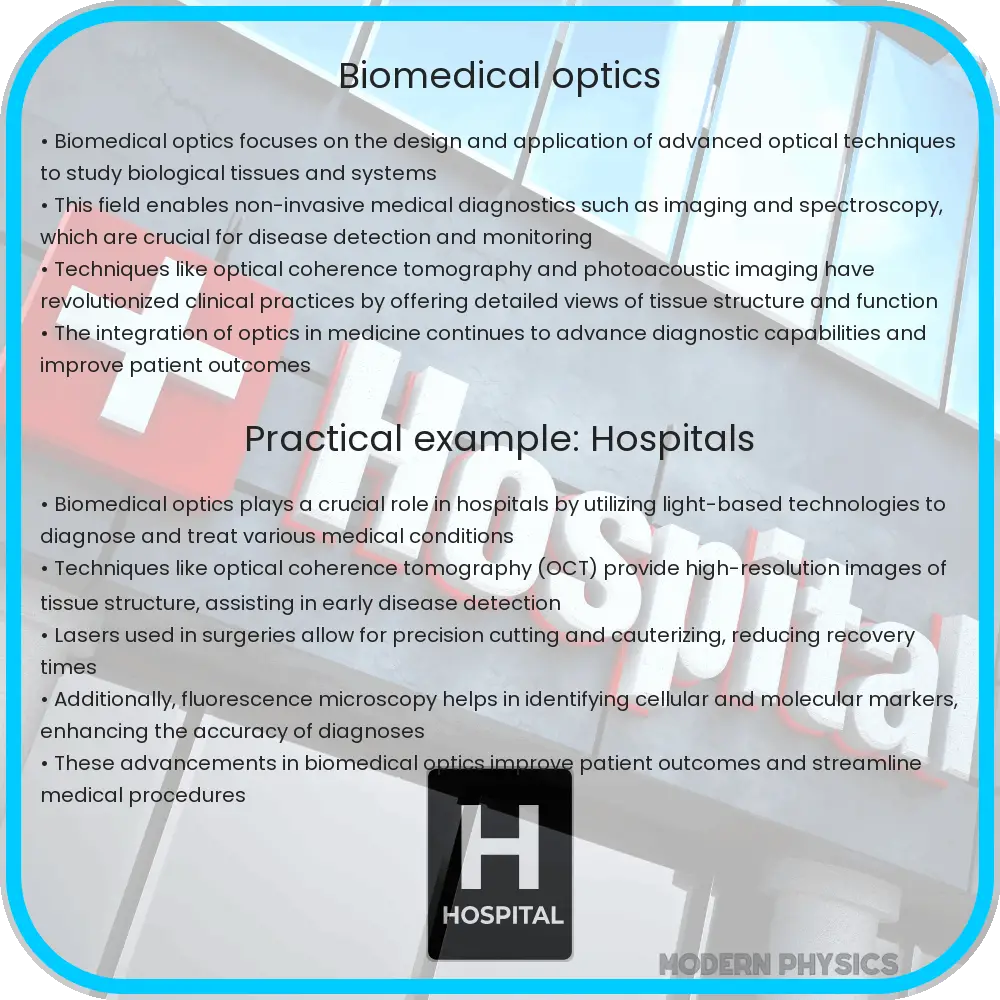Biomedical optics involves optical techniques for studying and treating living tissues, advancing diagnostic and therapeutic methods in medical science.

Introduction to Biomedical Optics
Biomedical optics refers to the application of optical techniques to study and treat living tissues. This interdisciplinary field encompasses both diagnostic and therapeutic methods, leveraging the interaction of light with biological tissues. Innovations in biomedical optics have revolutionized medical science, offering non-invasive procedures, enhanced imaging capabilities, and new therapeutic approaches. This article explores the cutting-edge technologies in this field and their significant medical applications.
Diagnostic Applications of Biomedical Optics
One of the primary uses of biomedical optics is in medical diagnostics. Techniques such as Optical Coherence Tomography (OCT), fluorescence imaging, and biophotonics are pivotal in this regard.
- Optical Coherence Tomography (OCT): OCT is akin to ultrasound imaging, except it uses light instead of sound. It offers high-resolution, cross-sectional imaging of tissues, beneficial for ophthalmology, dermatology, and cardiology. OCT can image microstructures within the retina to help diagnose eye diseases like glaucoma and macular degeneration.
- Fluorescence Imaging: This technique involves the use of fluorescent dyes that emit light when excited by a laser. It is widely used in cellular and molecular biology to visualize and track biological processes in real-time.
- Biophotonics: This technology investigates the interaction of light with biological materials. By studying the scattering and absorption of light, researchers can detect diseases at very early stages. For instance, using biophotonics in cancer research allows for the detection of minute tumors that are often missed by conventional imaging techniques.
Therapeutic Applications of Biomedical Optics
Biomedical optics is not limited to diagnosis; it also offers various therapeutic options such as photodynamic therapy (PDT) and laser surgery, which provide less invasive alternatives compared to traditional surgical methods.
- Photodynamic Therapy (PDT): PDT involves the combination of light-sensitive drugs and laser light to destroy cancer cells. The drug is administered and accumulates in the cancer cells, and upon exposure to light, it reacts and produces a form of oxygen that kills the cells. PDT is commonly used in the treatment of skin cancer and is being explored for other types of cancer as well.
- Laser Surgery: Lasers offer precise control and are less invasive, making them an ideal tool for numerous surgical procedures, such as correcting vision and removing tumors. Laser surgery minimizes bleeding, reduces the risk of infection, and speeds up recovery time.
These therapeutic applications highlight the ability of biomedical optics to treat diseases with precision and minimal patient discomfort, marking a significant shift from more invasive traditional methods.
Emerging Trends in Biomedical Optics
The field of biomedical optics continues to evolve, with emerging technologies promising even greater advancements in medical diagnostics and treatments. Researchers are looking into new applications such as photoacoustic imaging and optogenetics, which could drastically alter how medical professionals diagnose and treat various conditions.
- Photoacoustic Imaging: This technology combines optical imaging and ultrasound to provide high-resolution images deep within tissues. It is particularly useful for visualizing vascular structures and monitoring blood flow, which can be crucial in detecting and treating cardiovascular diseases.
- Optogenetics: In this cutting-edge technique, light-sensitive proteins are introduced into specific types of cells in the nervous system. By illuminating these proteins, scientists can control and study the activities of neurons with unprecedented precision, offering new insights into brain function and potential treatments for neurological disorders.
Challenges and Future Prospects
Despite its numerous advantages and potential, the field of biomedical optics faces several challenges. These include the need for better standardization across different technologies and protocols, improving the depth and resolution of imaging techniques, and making these advanced technologies more accessible and affordable for healthcare systems around the world. Furthermore, ethical considerations related to genetic privacy, especially in technologies like optogenetics, require careful consideration.
Looking ahead, continuous research and collaboration among scientists, engineers, and clinicians are essential to overcoming these hurdles. The future of biomedical optics looks promising, with potential breakthroughs that could even further revolutionize the way we diagnose and treat diseases.
Conclusion
Biomedical optics is a dynamic and rapidly growing field that merges the intricate world of light with medical science to create less invasive, more accurate diagnostic and therapeutic methods. From diagnosing eye diseases with Optical Coherence Tomography to treating cancer through Photodynamic Therapy, biomedical optics enhances patient care significantly. As new technologies like photoacoustic imaging and optogenetics continue to emerge, they hold the promise of pioneering even more innovative approaches in medical practice. By addressing current challenges and leveraging the synergy between various scientific disciplines, biomedical optics is poised to continue its impactful journey in transforming healthcare.
